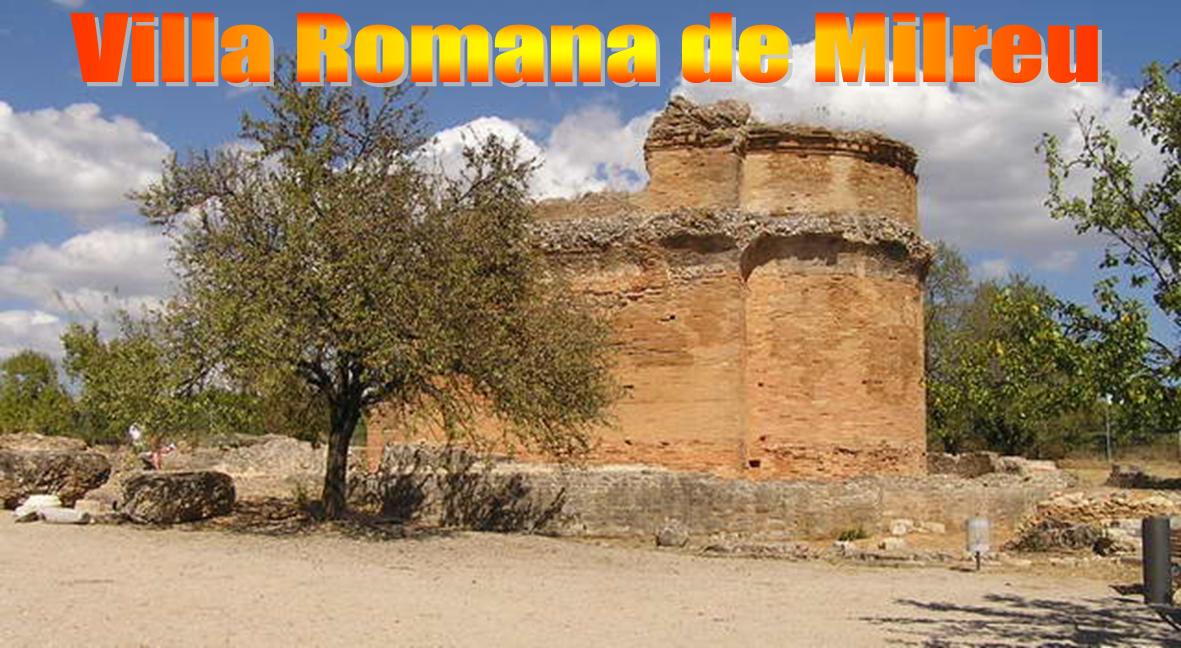
![[PT]](https://imgproxy.geocaching.com/fd803be3bfb7396e826555e469c7752394fb37ae?url=http%3A%2F%2Ffarm1.static.flickr.com%2F212%2F481411265_8928121d68_o.gif) Bem vindo a esta cache que se situa em Estói, freguesia do
concelho de Faro, e que vos dá a conhecer a Villa Romana
de Milreu.
Bem vindo a esta cache que se situa em Estói, freguesia do
concelho de Faro, e que vos dá a conhecer a Villa Romana
de Milreu.
Esta é uma importante villa romana no sul do
nosso território cuja origem esteve certamente ligada ao
crescimento económico da Hispânia no séc. I . Mais tarde foi
transformada em edifício de luxo. É o que resta desse edifício que
agora quero-vos mostrar.
![[EN]](https://imgproxy.geocaching.com/26dce0e20e21dd7e2c84c6c439fc1ab0a1b1385f?url=http%3A%2F%2Ffarm1.static.flickr.com%2F179%2F481411263_e6595005a4_o.gif) Welcome to this cache that she places in Estói, close to Faro, and
gives to you to know the Villa Roman of Milreu.
Welcome to this cache that she places in Estói, close to Faro, and
gives to you to know the Villa Roman of Milreu.
This is an important Villa Roman in the south of
our territory whose origin was certainly on to the economic growth
of the Hispânia in sec. I. Later it was transformed into luxury
building. It is what it remains of this building that now I want to
show you.

![[PT]](https://imgproxy.geocaching.com/fd803be3bfb7396e826555e469c7752394fb37ae?url=http%3A%2F%2Ffarm1.static.flickr.com%2F212%2F481411265_8928121d68_o.gif) O local das ruínas
O local das ruínas
Em 1887 Estácio da Veiga efectuou uma escavação
em extensão destas ruínas. Os arqueólogos puseram a descoberto
sobre tudo o complexo edificado no sec. III, constituído por uma
casa senhorial de grandes dimensões, instalações agrícolas, um
balneário e um templo. Estão ainda por explorar as construções
iniciais do sec.I com paredes de taipa assentes em bases de
alvenaria e sobre as quais foram erguidos os edificios mais
tardios.
 Foi
já no séc.IV que foi construído um edifício religioso ricamente
ornamentado invulgar para uma villa romana , cuja construção
central de tijolos com abside circular ainda hoje sobressai acima
das ruínas, ainda hoje conservado até ao arranque das abóbadas e
que se tornou imagem de marca deste lugar, pois não fica
indiferente a quem passa por ali na estrada que liga a velhinha EN2
a Estói.
Foi
já no séc.IV que foi construído um edifício religioso ricamente
ornamentado invulgar para uma villa romana , cuja construção
central de tijolos com abside circular ainda hoje sobressai acima
das ruínas, ainda hoje conservado até ao arranque das abóbadas e
que se tornou imagem de marca deste lugar, pois não fica
indiferente a quem passa por ali na estrada que liga a velhinha EN2
a Estói.
Só quando as abóbadas deste edifício religioso
ruíram no sec. X o sítio de Milreu foi provavelmente abandonado.
Mas muito mais tarde, já no início do séc. XVI o local voltaria a
ganhar vida com a construção de uma nova casa sobre as ruínas aí
existentes, casa essa que hoje se mantém e que está enquadrada no
complexo, e é o único e precioso exemplar algarvio deste tipo de
arquitectura civil com contrafortes cilíndricos.
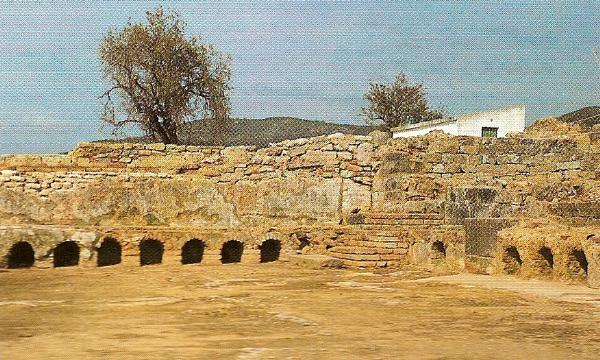 Quanto à área residencial, hoje visitável, ela aproveitou
parte das construções da anterior villa e organiza-se em torno de um peristilo
central - com 22 colunas -, que rodeia um pátio aberto com jardim e
respectivo tanque de água. A villa
foi embelezada com mosaicos, nomeadamente a nascente do peristilo,
com a representação de fauna marinha.
Quanto à área residencial, hoje visitável, ela aproveitou
parte das construções da anterior villa e organiza-se em torno de um peristilo
central - com 22 colunas -, que rodeia um pátio aberto com jardim e
respectivo tanque de água. A villa
foi embelezada com mosaicos, nomeadamente a nascente do peristilo,
com a representação de fauna marinha.
Durante a escavação da villa apareceram
também restos de esculturas em mármore, encontrando-se entre elas
três bem conservados bustos imperiais, que são excepcionais na
decoração de uma villa: a imperatriz Agripina (Séc. I d.c.),
o imperador Adriano (Séc. II d.c.) e o imperador Galieno (Séc. III
d.c.).
Esta villa foi classificada como Monumento
Nacional em 16-06-1910.
Para obterem uma informação mais completa sobre
as ruínas devem solicitar a respectiva brochura no Centro de
Interpretação à entrada da mesma.
![[EN]](https://imgproxy.geocaching.com/26dce0e20e21dd7e2c84c6c439fc1ab0a1b1385f?url=http%3A%2F%2Ffarm1.static.flickr.com%2F179%2F481411263_e6595005a4_o.gif) The local of the ruins
The local of the ruins
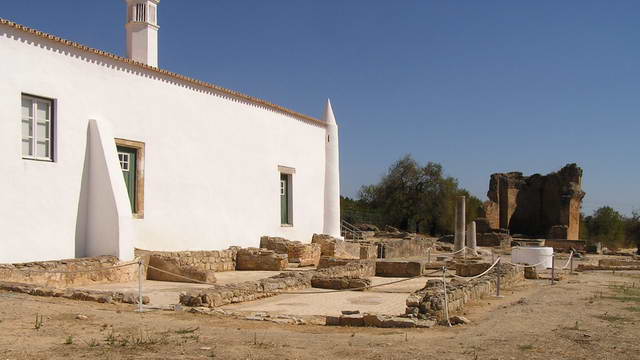
IIn 1887 Estácio da Veiga valley made a
hollowing in extension of these ruins. The archaeologists had above
all put short the built complex in sec. III, constituted of one he
marries senhorial of great dimensions, agricultural installations,
a health-resort and a temple. They are still for exploring the
initial constructions of sec. I with walls of taipa you seat in
masonry bases and on which the edificios had been raised most
delayed.
He was no longer séc.IV that a religious building richly decorated
was constructed to invulgar for a Villa Roman, whose central
construction of bricks with abside to circulate sobressai above of
the ruins, still today conserved until the o has still today pulled
out of the vaults and that if it became image of mark of this
place, therefore is not indifferent to who passes that way in the
road that binds velhinha EN2 the Estói.
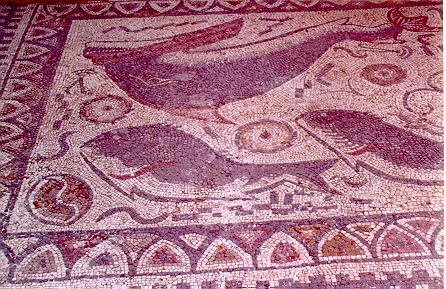
When the vaults of this religious building only
ruíram in sec. X the small farm of Milreu probably was abandoned.
But much more late, no longer beginning of séc. XVI the place would
come back to gain life with the construction of a new house on the
there existing ruins, house this that today is remained and that it
is fit in the complex, and is the only precious e exemplary algarve
of this type of civil architecture with cylindrical abutments.
How much to the residential area, today visitable, it it used to
advantage part of the constructions of the previous Villa and is
organized around one peristilo central - with 22 columns -, that it
encircles a patio opened in garden and respective water tank. The
Villa was embelezada with mosaics, nominated the spring of
peristilo, with the representation of sea fauna.
During the hollowing of the Villa remaining portions of sculptures
in marble had also appeared, meeting enter they three good
conserved imperial busts, that are bonanza in the decoration of a
Villa: empress Agripina (Séc. I d.c.), emperor Adriano (Séc. II
d.c.) and emperor Galieno (Séc. III d.c.).
This Villa was classified as National Monument
in 16-06-1910.
To get a more complete information on the ruins they must request
the respective paperback in the Center of Interpretation to the
entrance of the same one.
![[PT]](https://imgproxy.geocaching.com/fd803be3bfb7396e826555e469c7752394fb37ae?url=http%3A%2F%2Ffarm1.static.flickr.com%2F212%2F481411265_8928121d68_o.gif) Informação Útil
Informação Útil
Para obter informações úteis sobre as ruínas não deixem de visitar
os links abaixo:
http://www.ippar.pt/monumentos/sitio_milreu.html
http://www.ippar.pt/patrimonio/itinerarios/alent_algarve/itin_milreu.html
Acessos
Acesso a Deficientes:
O Centro de Acolhimento possui rampas de acesso, assim como em
determinadas zonas da própria visita. Contudo, existem algumas
escadas que poderão dificultar a passagem dos visitantes que se
desloquem em cadeiras de rodas.
O acesso faz-se pela estrada EN 2 Faro - S. Brás de
Alportel, junto ao nó de Estói do IP 1 - Via do Infante, a 9 km de
Faro. Na localidade de Coiro da Burra vira-se em direcção a Estói.
Atravessando a ponte sobre o Rio Seco encontra-se, pouco depois, à
esquerda, a entrada para as ruínas.
Transportes públicos: carreira da Eva,
Faro-Estói.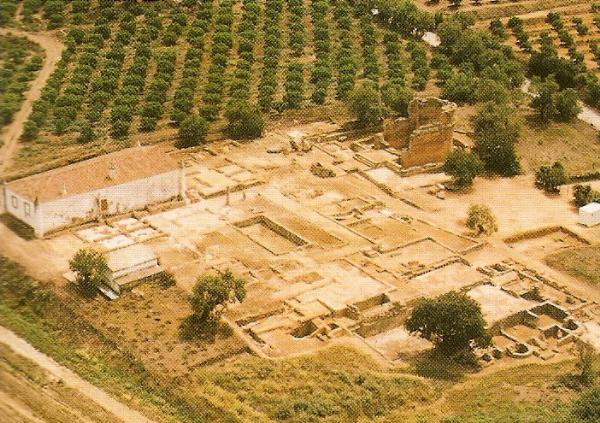
Parque de estacionamento para ligeiros e
autocarros.
![[EN]](https://imgproxy.geocaching.com/26dce0e20e21dd7e2c84c6c439fc1ab0a1b1385f?url=http%3A%2F%2Ffarm1.static.flickr.com%2F179%2F481411263_e6595005a4_o.gif) Util information
Util information
To get useful information on the ruins please
visit links below:
http://www.ippar.pt/monumentos/sitio_milreu.html
http://www.ippar.pt/patrimonio/itinerarios/alent_algarve/itin_milreu.html
Accesses:
Access the Deficient ones:
The Center of Shelter possesss access slopes, as well as in
determined zones of the proper visit. However, some stairs exist
that will be able to make it difficult the ticket of the visitors
who if dislocate in chairs of wheels.
The access becomes for 2 road EN Faro - S. Brás
de Alportel, next to the knot of Estói of IP 1 - Way of the Infant,
the 9 km of Faro. In the locality of Coiro of the She-ass the Estói
turns over in direcção. Crossing the bridge on the Dry River one
meets, shortly afterwards, to the left, the entrance for the
ruins.
Public transports: career of the Eva,
Faro-Estói.
Parking forBus and cars.


![[PT]](https://imgproxy.geocaching.com/fd803be3bfb7396e826555e469c7752394fb37ae?url=http%3A%2F%2Ffarm1.static.flickr.com%2F212%2F481411265_8928121d68_o.gif) A Cache
A Cache
Esta cache é um tupperware de tamanho regular
envolto num saco de plástico verde de tamanho +/- 15x15x10cm.
O conteudo inicial da cache além do Logbook,
stashnote, lápis, afia e documentação é:
- Bola de golfe
- Etiqueta de mala de viagem
- Boneco aranha
- carrinho
A cache não se encontra dentro da zona vedada
das ruínas romanas, não sendo por isso necessário pagar para chegar
à cache. No entanto ela está mesmo junto à entrada do recinto num
local pertíssimo da estrada e em linha de vista com a recepção do
Centro, por isso sejam MUITO DISCRETOS na procura desta cache.
Deixe-a exactamente como a encontrou, bem
escondida e tapada.
![[EN]](https://imgproxy.geocaching.com/26dce0e20e21dd7e2c84c6c439fc1ab0a1b1385f?url=http%3A%2F%2Ffarm1.static.flickr.com%2F179%2F481411263_e6595005a4_o.gif) The
Cache
The
Cache
This cache is one tupperware of regular size in a green plastic bag
of size +/- 15x15x10cm.
The initial content of cache beyond of the Logbook, stashnote,
pencil, sharpens and documentation is:
- Ball of golf
- Label of trip luggage
- Doll spider
- stand
Cache if inside does not find of the forbidden zone of the ruins
Romans, not being therefore necessary to pay to arrive at cache.
However it is same next to the entrance of the enclosure in a place
closest of on-line road and of sight with the reception of the
Center, therefore they are VERY DISCRETE in the search of this
cache.
Leave it exactly as it found it, hidden and covered well.
Ah, e não se esqueça nunca/don't forget: Cache
In Trash Out!
 ¤ menu
> início
:: Villa Romana de Milreu [Estói] ¤ menu
> início
:: Villa Romana de Milreu [Estói] |
translate:

|
|
|